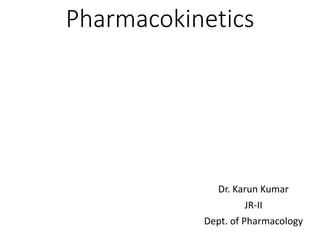
Pharmacokinetics
- 1. Pharmacokinetics Dr. Karun Kumar JR-II Dept. of Pharmacology
- 2. Definition • Absorption Movement of drug into the bloodstream • Distribution Drug leaving the bloodstream and going into the organs and tissues • Elimination 2 processes: biotransformation (metabolism) of a drug to one or more metabolites, primarily in the liver, and the excretion of the parent drug or its metabolites, primarily by the kidneys.
- 4. Absorption • Passage of drug molecules from the site of administration into the circulation • Applies to all routes except topical & i.v.
- 5. Processes of absorption 1. Passive diffusion Fick’s law (Rate of absorption ∝ i) drug conc. Gradient ii) Surface area for absorption a) Lipid diffusion Drug dissolves in lipid component of cell membrane b) Aqueous diffusion Passage through aqueous pores in cell membrane
- 6. 2. Active transport (5-FU) Requires carrier molecule Req. energy (hydrolysis of ATP) Against conc. Gradient 3. Facilitated diffusion Req. carrier mo. No energy reqd. not against conc. gradient
- 7. Effect of pH • Drugs are weak acids/bases existing in nonionized & ionized form in body • Nonionized form crosses membrane lipids
- 9. Drug distribution • Drugs are distributed to organs and tissues via the circulation, diffusing into interstitial fluid and cells from the circulation. • ATP-driven drug efflux pumps, known as ABC transporters (ABC is an acronym for “ATP-binding cassette”). • The most studied of these proteins, called permeability glycoprotein or P-glycoprotein (Pgp), is expressed on the luminal side of endothelial cells lining the intestines, brain capillaries, and a number of other tissues.
- 10. • Drug transport in the blood-to-lumen direction leads to a secretion of various drugs into the intestinal tract, thereby serving as a detoxifying mechanism. • Pgp also serves to exclude drugs from the brain. • The Pgp proteins exclude drugs from tissues throughout the body, including anticancer agents from tumors, leading to chemotherapeutic drug resistance. • Inhibition of Pgp by amiodarone, erythromycin, propranolol, and other agents can increase tissue levels of these drugs and augment their pharmacologic effects
- 12. Factors affecting distribution 1. Organ blood flow Rapidly distributed to highly perfused tissues (brain, heart, liver, and kidney) ; More slowly to less perfused tissues (skeletal muscle) and even more slowly to those with the lowest blood flow (skin, bone, and adipose tissue) 2. Plasma protein binding Acidic drugs bind to albumin and basic drugs to glycoproteins and β- globulins
- 13. 3. Molecular size Affects distribution of extremely large molecules (heparin) 4. Lipid solubility BBB (Formed by tight junctions between the capillary endothelial cells and also by the glial cells that surround the capillaries) which inhibit the penetration of polar molecules into brain neurons.
- 14. Drug biotransformation • Biotransformation/drug metabolism Enzyme- catalyzed conversion of drugs to their metabolites. • Liver, gut, kidneys, brain, lungs, and skin • Phase I Rx Oxidative, hydrolytic & reduction rxns
- 16. Phase I biotrans 1. Oxidative rx Most common type of phase I rx catalyzed by microsomal cytochrome P450 (CYP) monooxygenase system CYP1, CYP2, and CYP3. Eg:- codeine, ppnl,Ibuprofen 2. Hydrolytic rx Esters & amides (Lidocaine, Procainamide, Aspirin, Esmolol) 3. Reductive rx Chloramphenicol & Nitroglycerine
- 17. Phase II biotransf. • Conjugation with acetate, glucuronate, sulfate, or glycine (+nt in cytoplasm exc. Glucuronosyl transferase in SER) • Most metabolites r inactive 1. Glucuronide PCM, Morphine, Oxazepam 2. Acetylation SHIP 3. Sulfation Acetaminophen, minoxidil, triamterene
- 18. Pharmacogenomics 1. Variations in Acetyltransferase Activity Slow acetylators (SAs) identified by neuropathic effects of isoniazid, is autosomal recessive.About 15% of Asians, 50% of Caucasians and Africans, and more than 80% of Mideast populations have the SA phenotype. Other drugs that may cause toxicity in the SA patient are sulfonamide antibiotics, the antidysrhythmic agent procainamide, and the antihypertensive agent hydralazine.(SHIP)
- 19. Variations in CYP2D6 and CYP2C19 Activity • Genetic polymorphisms of CYP2D6 and CYP2C19 enzymes are well characterized, and human populations of “extensive metabolizers” and “poor metabolizers” have been identified. • CYP2D6 substrates Majority are extensive metabolizers but 10% of Caucasians and a smaller fraction of Asians and Africans are poor metabolizers (Psychotropic drug, codeine) • Poor metabolizers of CYP2C19 substrates have higher plasma levels of omeprazole & vice versa
- 20. • About 1 in 3000 individuals exhibits a familial atypical cholinesterase that will not metabolize succinylcholine. Affected individuals are subject to prolonged apnea after receiving the usual dose of the drug. • TPMT (Thiopurine S-methyl transferase) for 6-mp and azathio. In Caucasians, the most common variant allele for TPMT is TPMT*3A. Subjects homozygous for TPMT*3A are at greatly increased risk for life-threatening myelosuppression when treated with standard doses of thiopurine drugs.
- 22. Drug excretion • Routes of exc. urine, bile, sweat, saliva, tears, feces, breast milk, and exhaled air. 1. Glomerular Filtration free drug enters the renal tubule as a dissolved solute in the plasma fitrate 2. Active Tubular Secretion secretion of penicillins is inhibited by probenecid. 3. Passive Tubular Reabsorption Depends on the lipid solubility of the drug Drug elim. = Drug m-bol. + exc. Removal of drugs from body fluids
- 23. Clearance • Measure of the rate of elimination • volume of body fluid (blood) from which a drug is removed per unit of time • Calculated by dividing the excretion rate (1200 mg/min) by the plasma drug concentration (3 mg/mL). The result is 400 mL/min, which is equal to 24 L/hr.
- 27. The volume of distribution (Vd) is defined as the volume of fluid in which a dose of a drug would need to be dissolved to have the same concentration as it does in plasma
- 28. Steady state principle • Drug is 1st admin Rate of admin. > Rate of elim. • As the drug continues to be administered, the rate of drug elimination gradually increases, whereas the rate of administration remains constant. • Eventually, as the plasma concentration rises sufficiently, rate of drug elim = rate of admin. • At this point the steady-state equilibrium is achieved.
